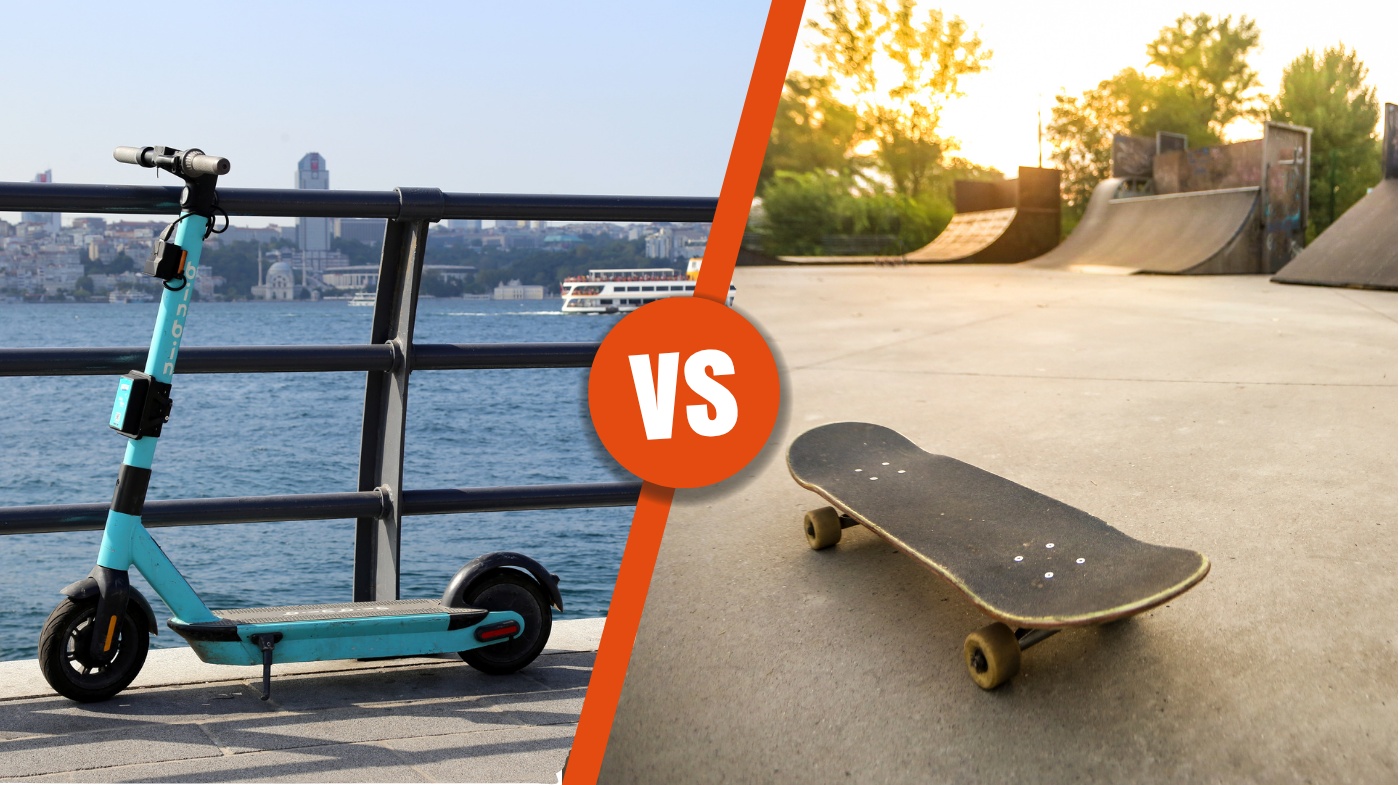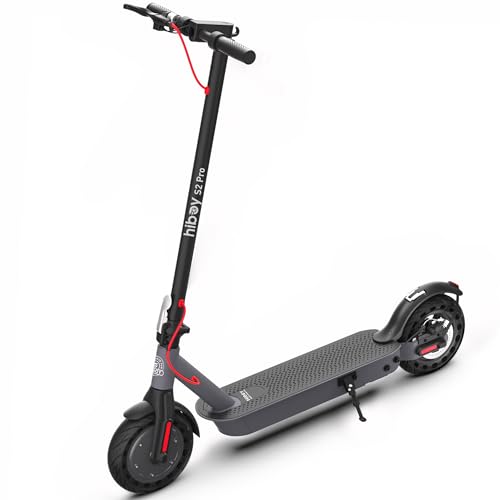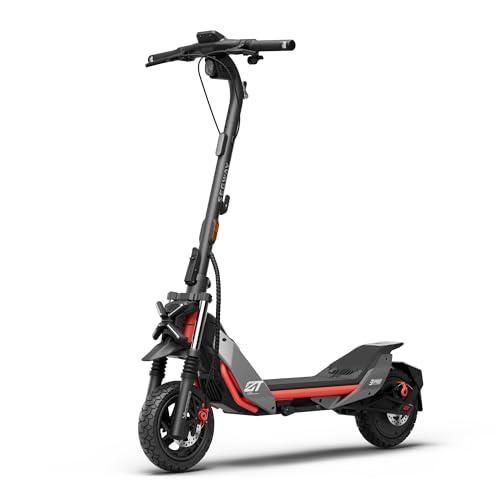If you want stability and easy control, a scooter’s handlebars make it simpler to learn and safer for beginners, while skateboards require better balance and skill.
Scooters are heavier but offer smoother rides and longer ranges, perfect for medium-distance urban trips. Skateboards are lighter, portable, and can reach higher speeds but demand more effort.
Both need helmets and pads for safety. If you’re curious about their speed, injury risks, and best uses, keep exploring for detailed insights.
- Product Note: Max speed and range per charge vary based on several factors, including: rider weight,…
- Powerful Motor & Long Battery Life – The 500W powerful electric brushless hub motor allows for…
- Upgrade Your Commuting – Hiboy S2 Pro Electric Scooters Front And Rear Wheel Equipped With 10-Inch…
- Solid&Durable : 7 layers Canadian maple deck,31.75″*7.88″, offers perfect balance between toughness…
- Smooth&Speedy : Super smooth (52mm,95A)High rebound PU wheels with ABEC-9 precision bearings and 95A…
- Master New Tricks : ️Design for beginners and skilled, double kick dissymmetric concave combines…
Key Takeaways
- Scooters are easier to learn and control with handlebars, offering better stability and safer braking for beginners than skateboards.
- Skateboards are more portable and lightweight, fitting easily into backpacks, making them ideal for short trips and last-mile travel.
- Electric skateboards can reach higher speeds (up to 68 mph) compared to scooters, which typically max out around 15-25 mph.
- Both require helmets and protective gear; scooters have more upper limb injuries, while skateboards have higher risks of head and wrist trauma.
- Choose scooters for comfort and medium-range urban commuting; choose skateboards for speed, portability, and flexibility in crowded areas.
Key Differences at a Glance of Scooters vs Skateboards
| Feature | Scooter | Skateboard |
|---|---|---|
| Learning Curve | Easier – handlebars provide stability | Harder – requires better balance and skill |
| Safety | Safer – easier braking and control | Higher injury risk – more hospitalizations |
| Speed | Slower but more controlled | Faster – averaging 9.7 mph |
| Weight & Portability | Heavier but smoother rides | Lighter and more portable |
| Terrain | Better comfort – absorbs bumps well | More challenging – speed wobbles limit safe speeds |
| Best For | Beginners and medium-distance urban trips | Experienced riders seeking agility and speed |
Ease of Riding Comparison
While both scooters and skateboards offer fun ways to get around, scooters generally make it easier for beginners to pick up riding quickly because their handlebars provide essential stability and balance support.
When you ride a scooter, steering feels intuitive—you simply turn the handlebars, which helps you maintain control and confidence. Pushing off for speed is also more stable, as you can balance on one foot while holding the handlebars securely.
Additionally, scooters feature decks with feet always positioned between the wheels, facilitating easier tight turns and obstacle navigation, which boosts maneuverability for new riders deck design. Many scooters also include a folding mechanism that enhances portability and storage convenience.
In contrast, skateboarding demands more practice; you must balance entirely on the board, use body weight shifts to steer, and master foot propulsion without hand support. This makes initial learning more challenging and increases the risk of falls.
Portability and Convenience Factors
Because portability and convenience play crucial roles in choosing your ride, understanding how scooters and skateboards compare in these areas helps you make a practical decision.
Skateboards are lighter and more compact, fitting easily in backpacks or under desks. Scooters fold for storage but remain bulkier and heavier, making them less convenient for carrying long distances or on crowded transit. Both have pros depending on your space and commute style.
Additionally, scooters generally offer a foldable and space-efficient design that makes them suitable for urban environments where storage space is limited. Considering the weight and size of your ride is essential to ensure comfort and ease during transport.
Speed and Travel Efficiency Insights
When comparing average speeds, electric skateboards often outpace standard electric scooters. But scooters hold steady with reliable acceleration suitable for urban travel. Many riders also consider the stability and control differences between these devices when making their choice.
You’ll find human-powered skateboards offer limited range due to rider effort, while electric models extend your travel considerably. Understanding these differences helps you choose the right ride based on speed needs and travel distance.
Additionally, scooters are generally more practical for short-distance commuting and recreation due to their design and features, making them a convenient option in many cities (performance and practicality).
Average Speeds Compared
Although both scooters and skateboards offer convenient urban mobility, their average speeds and travel efficiencies differ markedly. You’ll find electric scooters typically cruise around 12-25 mph, benefiting from stable handlebars and easier acceleration.
This stability lets you maintain consistent speeds with less effort, especially over longer distances. Many modern scooters also incorporate advanced motor technology to enhance performance and safety at these speeds.
On the other hand, electric skateboards average similar top speeds but require more balance and frequent pushing, limiting sustained speed and causing more fatigue.
Additionally, factors like motor power, battery capacity, and wheel size greatly influence the top speed and efficiency of electric skateboards, which can vary significantly between models speed influences. Non-electric kick scooters are slower, generally topping out near 6-12 mph since they rely solely on your leg power.
Maneuverability further affects speed—you can turn quicker and stop more efficiently on scooters, helping maintain higher average speeds safely. So, if you prioritize consistent speed and less fatigue, scooters usually have the edge over skateboards.
Electric Models Performance
If you’re comparing electric scooters and skateboards, understanding their speed capabilities and travel efficiency is key. Electric skateboards can reach higher top speeds, often between 20 to 40 mph, with some models hitting up to 68 mph.
Scooters usually top out around 15 to 30 mph due to regulations. Skateboards excel on varied terrain and inclines, while scooters perform best on smooth, flat surfaces.
It is important to perform pre-ride checks to ensure optimal scooter performance and safety. Battery life varies, with skateboards generally offering longer ranges.
| Feature | Electric Skateboard | Electric Scooter |
|---|---|---|
| Top Speed | 20-68 mph | 15-30 mph |
| Acceleration | Quick, high-torque motors | Steady, controlled |
| Terrain Handling | Better on rough/uneven ground | Best on flat, paved surfaces |
| Battery Range | 10-31 miles | 10-20 miles |
| Maneuverability | Agile, requires skill | Stable, beginner-friendly |
Human-Powered Travel Range
Electric models offer impressive speeds and extended ranges, but understanding how human-powered scooters and skateboards compare helps you gauge their practical travel potential without relying on batteries.
Human-powered scooters typically reach speeds close to bicycles, averaging around 11-12 mph, thanks to handlebar stability and efficient propulsion.
According to studies, scooter speeds tend to stay below 15 mph, aligning with common micro-mobility speed profiles. Their wheel size and construction also contribute to better stability and control at these speeds.
Skateboards, averaging 9.7 mph, are faster than walking but slower than scooters, partly due to balance demands and speed wobbles limiting safe speeds.
Scooters’ better directional control and braking ease let you maintain smoother, steadier speeds and reduce energy spent on balance.
Meanwhile, skateboards provide portability advantages but may slow you down on short trips because mounting and dismounting require extra time.
Safety and Injury Statistics Overview
You’ll notice that skateboard injuries land more kids in the hospital than scooter injuries, especially among those aged 10 to 14. Younger children face higher risks on scooters, but both activities share common dangers like falls and fractures.
Fork mounts are generally more secure due to their frame attachment, reducing the risk of accidental damage. In fact, around 1,500 hospitalizations occur annually in the U.S. due to skateboard injuries. Wearing protective gear, especially helmets, plays a vital role in reducing the severity of these injuries.
Injury Rates Comparison
Although both skateboards and scooters pose injury risks, skateboarding leads to considerably more emergency room visits in the U.S., with over 125,000 reported injuries in 2015 alone. Proper maintenance of equipment, such as regular cleaning and lubrication, can reduce injury risks by ensuring optimal performance and safety.
Scooter injuries, by comparison, were estimated at 9,400 emergency visits during an eight-month span in 2000, mostly involving children under 15.
Skateboard injuries also result in more hospitalizations and severe cases like head trauma and fractures. Many of these injuries involve extremities such as wrists and ankles, which account for approximately 74% of cases extremity injuries.
While skateboard injury rates have declined over time, scooter injury rates have remained steady. You should note that skateboarders more often suffer wrist and intracranial injuries, whereas scooters cause more upper limb fractures.
Age and Safety Risks
Since age plays a crucial role in injury risk, understanding who typically uses scooters and skateboards helps you gauge safety concerns better.
Scooters mainly attract children around 8 years and older, with injuries peaking near 7.9 years. Proper helmet use can significantly reduce the risk of serious head injuries for these young users, emphasizing the need for helmet safety.
While skateboarding is popular among kids aged 5 to 14. Boys tend to be older when injured on scooters, possibly due to greater risk-taking.
Most injuries occur from falls, especially head injuries, highlighting vulnerability in younger kids still developing motor skills. Awareness of safety gear such as helmets, reflective clothing, and pads is essential to minimize these risks.
Injuries spike in warmer months and late afternoons when outdoor activity increases. Recognizing these patterns helps you anticipate risks linked to age, gender, and timing.
Protective Gear Importance
When you gear up properly, you drastically cut your risk of injury while scootering or skateboarding. Helmets alone prevent about 85% of head injuries, the most common and severe type in these sports. Yet, many riders skip helmets, increasing their chance of serious trauma.
Elbow pads reduce injury risk by 82%, and knee pads cut knee injuries by 32%, so wearing them matters. Wrist guards help skateboarders but may hinder scooter riders.
With scooter injuries in kids under 15 soaring, protective gear becomes essential. Emergency room visits for scooter accidents surged 700% with scooter popularity. Proper maintenance and adjustment of equipment, similar to clutch adjustment techniques, can also help prevent accidents caused by mechanical failure.
Riding Technique and Skill Level Differences
If you’re new to scootering or skateboarding, you’ll notice that scooters make getting started easier thanks to their handlebars, which provide steady support as you push off and steer. This handlebar simplifies balance and control, letting you focus on propulsion without wobbling.
Skateboards, on the other hand, demand you balance on one leg while pushing with the other, requiring more core strength and coordination from the start. Steering on a scooter is intuitive—you just turn the handlebar—while skateboarding relies on subtle weight shifts for direction, making it trickier.
Scooters also offer easier braking and tighter turns, ideal for beginners. Additionally, scooters allow for higher speeds and greater control, especially on turns, which can provide a smoother experience and more confidence in maneuvering.
However, skateboarding builds superior dynamic balance and proprioception over time, despite the steeper learning curve. Your choice depends on whether you prefer quicker mastery or a greater balance challenge.
Urban Utility and Practical Application
Although both scooters and skateboards serve urban commuters, their practical applications differ considerably based on range, maneuverability, and legal constraints.
Scooters and skateboards both aid urban travel but differ in range, agility, and legal rules.
You’ll find scooters better suited for medium-range trips, offering longer range and stable rides, while skateboards excel in tight, crowded areas thanks to superior maneuverability and compactness. Scooters typically have a maximum speed of around 15 mph, which balances safety and efficiency for urban travel.
Legal rules also shape your choice—scooters often face stricter regulations and designated lanes, whereas skateboards enjoy more freedom but may be banned in some zones.
Consider these factors for urban utility:
- Scooters cover 10–30 miles, ideal for daily errands and longer commutes
- Skateboards handle short trips up to 10 miles, perfect for last-mile connectivity
- Skateboards weave through crowds and fit easily on public transit
- Scooters require paved lanes and may have helmet or registration mandates
Advantages of Electric Scooters and Skateboards
Since urban mobility demands efficient and eco-friendly solutions, electric scooters and skateboards offer compelling advantages that address both environmental concerns and practical commuting needs. You’ll appreciate that both produce zero CO2 emissions during use, cutting down pollution and easing city traffic.
Scooters run on rechargeable batteries, making them a greener choice for short trips, while electric skateboards use less complex batteries, adding portability without sacrificing eco-friendliness. Their low maintenance costs and ease of upkeep make them an economical option for daily commuters.
You’ll save money too, with low purchase and maintenance costs—charging is cheaper than fuel.
When you’re steering through traffic, scooters reach speeds of 20–25 km/h, while skateboards average 16–30 km/h, both helping you cut commute times.
Plus, their compact designs let you carry them easily and combine with public transit, boosting convenience for urban travel.
Age Recommendations and Safety Gear Importance
Understanding the age recommendations and the significance of appropriate safety gear will help you maximize the benefits of electric scooters and skateboards while minimizing risks.
Kids under 5 shouldn’t ride at all, and those between 5 and 14 need supervision—especially under age 10. It is also important to remember that head injuries are the most common cause of serious hospitalizations among skateboarders, highlighting why helmets are indispensable.
Wearing the right protective gear is vital to prevent serious injuries.
Keep these key safety points in mind:
- Always wear a helmet that fits properly to protect against head injuries.
- Use wrist guards, elbow pads, and knee pads for impact protection.
- Opt for sturdy, closed-toe shoes with good grip to enhance control.
- Make certain riding happens in safe, designated areas under supervision.
Choosing Between Scooter and Skateboard Based on Needs
When deciding between a scooter and a skateboard, you’ll want to contemplate how each matches your specific needs and skill level.
If you seek ease of learning, stability, and comfort—especially over rough surfaces—a scooter’s handlebar support and simpler steering might suit you better.
Scooters also offer easier braking and greater ride comfort, reducing upper body fatigue. The scooter features pneumatic tires that help absorb bumps for a smoother ride.
On the other hand, if portability and speed are priorities, skateboards are lighter, easier to carry indoors, and can reach competitive speeds. However, skateboards demand more balance, skillful maneuvering, and pose higher injury risks.
Consider where you’ll ride: scooters handle tight spaces and bumps well, while skateboards excel in mixed commuting due to portability.
Align your choice with your riding environment, physical ability, and convenience preferences to ensure an enjoyable and safe experience.
Frequently Asked Questions
How Do Weather Conditions Affect Scooter and Skateboard Performance?
You’ll find weather seriously impacts electric ride performance. Wet conditions reduce traction, making control tricky and risking slips. Cold temperatures sap battery life and stiffen components, slowing you down.
Hot weather can overheat motors and batteries, cutting range and causing damage. Wind challenges your balance and forces motors to work harder, draining power faster. Rough terrain worsens these effects, so you’ll want to ride cautiously and pick smoother, drier days whenever possible.
What Are the Environmental Impacts of Scooters Versus Skateboards?
You might be surprised to learn how your ride impacts the planet. Electric scooters and skateboards produce zero tailpipe emissions, but their manufacturing and electricity use matter.
Non-electric skateboards? They’ve the lowest footprint since they’re fully human-powered. However, shared e-scooters increase emissions due to frequent gas-powered collections.
Choosing personal electric devices and charging with renewables can drastically cut your environmental impact while zipping through the city.
Can Scooters or Skateboards Be Customized With Accessories?
You can definitely customize both scooters and skateboards with various accessories. Scooters let you upgrade wheels, decks, grips, and add functional parts like lights or fenders for better control and style.
Skateboards offer customization through grip tape designs, wheels, trucks, and bearings, tailoring performance and look. Both allow you to express personal style while enhancing functionality, making your ride uniquely yours and better suited to your preferences and riding conditions.
Are There Legal Restrictions on Where Scooters and Skateboards Can Be Ridden?
You might think you can ride anywhere, but the law has other plans. Many places ban scooters and skateboards from sidewalks to keep pedestrians safe.
You’re often restricted to bike lanes or roads with lower speed limits, usually under 25-35 mph. Highways? Forget it. Some cities allow sidewalk riding, but others strictly forbid it. At night, you’ll need proper lights and reflectors.
Make Your Commute Smooth with the Best Pick
When deciding between a scooter and a skateboard, think of them as two keys opening different doors in your urban journey. Scooters offer swift convenience, while skateboards bring fluid style and skill.
Your choice hinges on ease, speed, and safety, like picking the right tool for your daily dance with the city streets. Equip yourself wisely, and whichever you choose will glide you smoothly through life’s fast lane.
- Extended Battery Life: Travel up to 43.5 miles on a single charge in ECO mode, ensuring long,…
- Effortless Control: Easy-to-use controls and intuitive handling make the scooter simple to operate,…
- Built for Durability: Constructed with high-quality materials designed to endure rough use and harsh…
- BUILT TO LAST: This Retrospec longboard blends 8-ply Canadian maple with sustainable bamboo,…
- SMOOTH CRUISING: Precision ABEC-7 bearings and 70mm polyurethane wheels work together to deliver…
- BITE-FREE RIDING: Engineered wheel wells prevent wheel bite, while the 85A PU wheels with rock…
Last update on 2026-01-11 / Affiliate links / Images from Amazon Product Advertising API





